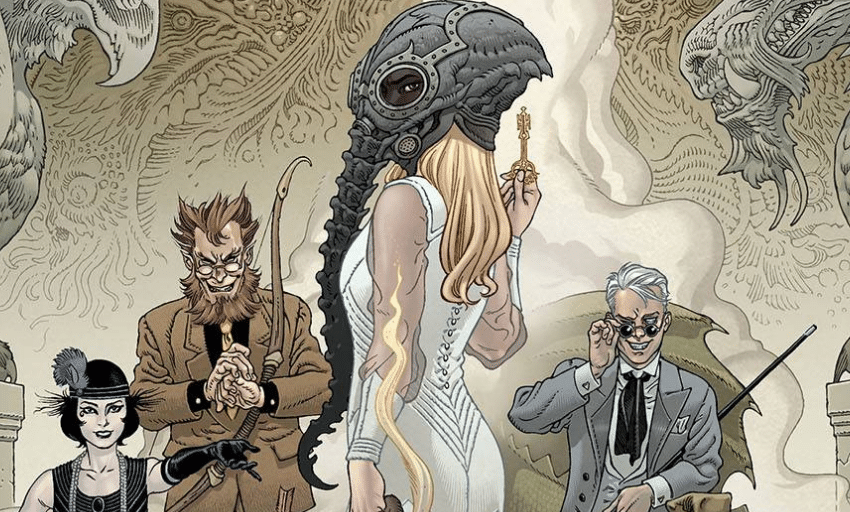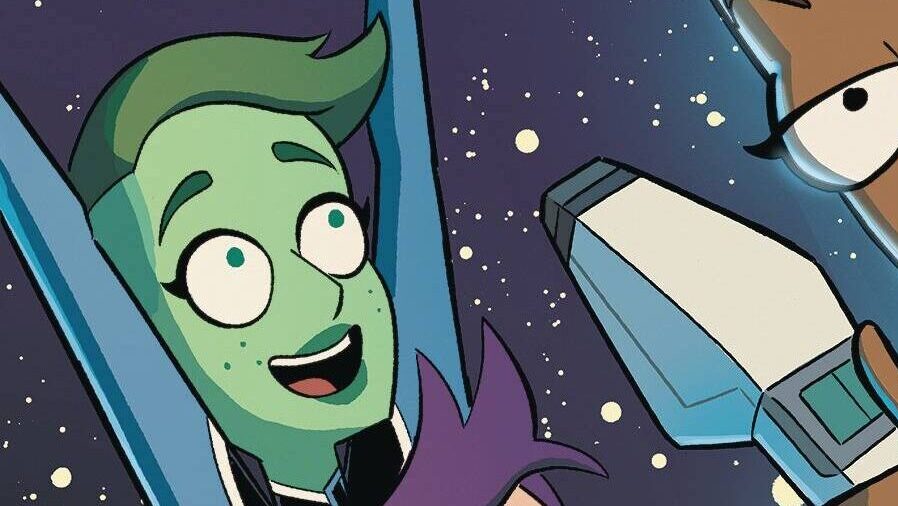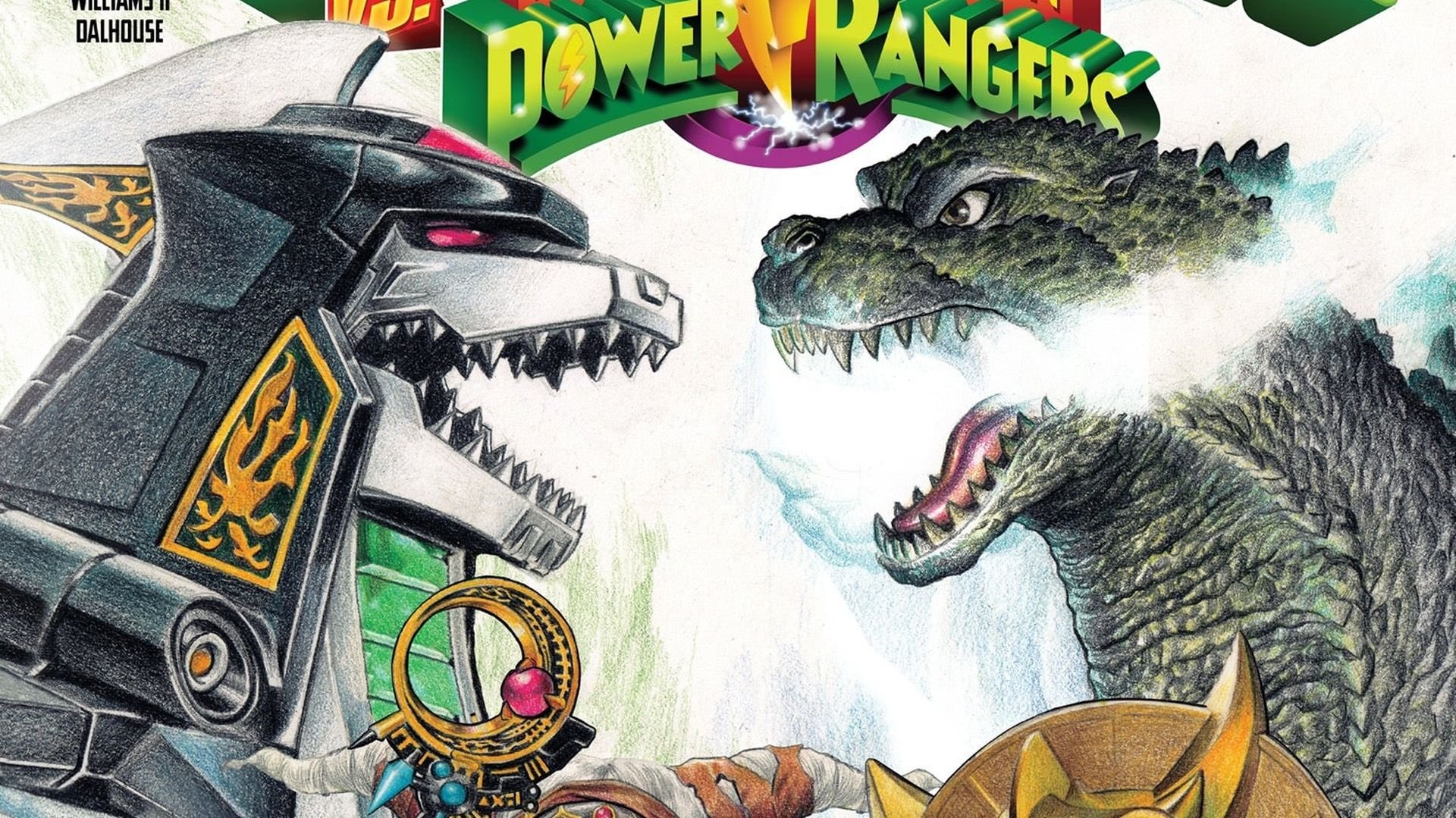The year is 1927, and two houses across the Atlantic are about to collide. At Keyhouse in Lovecraft, Massachusetts, Locke family patriarch Chamberlain is dying and regrets the loss of his son to Hell. On Fawney Rig in Sussex, England, Roderick Burgess holds court over his debauched followers and keeps the King of Dreams in his basement. Now, Mary Locke, hoping to ease her father’s suffering, has come to Fawney Rig to speak to the being in the basement, and to save her brother, and all manner of horrors await her in Locke & Key/The Sandman: Hell & Gone #1, written by Joe Hill, drawn by Gabriel Rodriguez, colored by Jay Fotos and lettered by Shawn Lee.
Matt Lazorwitz: Welcome, one and all, to a most macabre experience. If there was any comic of the past I’m-not-sure-how-long that I have been looking forward to, it is Locke & Key/Sandman. The moment this was announced, I called reviewing it, and that was back in the dusty days of WMQ Comics, so I’m especially excited to finally have read it. These are two of my favorite comic series of all time appearing together. What’s your history with these books, Armaan?
Armaan Babu: The Sandman comics kept me through a very lonely time at a difficult college experience. The Locke & Key comics were binged in a week with a voracity that few other properties have ever indulged in me. The most precious commodity I own is the second volume of the Sandman omnibus from a close friend. These stories are old, and they are integral to expanding my love for comics beyond capes, tights and emotionally fraught punching. I’m beyond excited they’re crossing over. Let’s dive in!
Theme and Form

ML: The heart of this story, beyond all the gothic trappings, is family, I think. The Sandman rested on a platform of the themes of duty, the power of stories and how much someone can change. Locke & Key was a coming-of-age story that was about a particular family, and so it feels natural that this is from the Locke & Key creators.
AB: While family is still very much at the heart of this story, I feel like the theme of duty has shifted, to looking at a somewhat more unexplored side of the Sandman mythos — mainly, what kind of chaos the Dreaming really descended to while the Lord of Dreams was out of play.
ML: Absolutely. We see the Dreaming only after 70 years of chaos in the original. Here, it’s only starting to come unraveled, and we see what one person who seeks power not out of a sense of duty, but of self-aggrandizement, can do, and what those who still have that sense of duty are subjected to. Oh, poor Lucien. Sandman stories after the original do tend to wind up with him in a bad spot…
AB: Honestly, there’s no way to do a Sandman story with Morpheus that doesn’t leave him in a bad spot, considering how things ended with him in the original series. I’m just heartened to see that he was capable of a little mischief before his larger, more epic story began.
ML: Yes. He’s only really appeared in his imprisonment in a couple stories, a Sandman Presents miniseries and Sandman Midnight Theatre, and he seemed fairly passive in both of those. This is the first example of him having any agency while captured by Burgess.
AB: Speaking of Burgess, though, he seems to be a much larger player than he was even in the original Sandman series. There, he was a man who was in over his head, a victim of his own hubris — but in this series, his sleaze, his greed and his ambition are all a little more fleshed out — deepening the tragedy of his end in the original series, while also giving us a somewhat unbeatable villain; he can’t fail, or fail extravagantly, before Sandman canon says he does.
ML: And he’s an interesting counterpoint to Chamberlain Locke, the patriarch of the Locke family. Burgess is cruel and dismissive of his son, Alex. He makes snide comments about the boy after breaking a promise to him, something he clearly does often. He is the head of a household but wants nothing to do with it; another dereliction of duty. Meanwhile, Chamberlain is haunted by his moment of rage at his son. His moment where he acted with cruelty is the thing that has haunted him for a decade, while Burgess probably won’t remember this cruelty, as it is in the middle of a sea of so many.
AB: While Burgess gets an uncomfortable amount of “Daddy” titling this issue, there’s definitely a lot to be said for themes of fatherhood here — specifically, where fathers fall short, and when it’s up to the children of the family to fill in for an older generation’s mistakes. Even Morpheus himself, with his involuntarily abandoned creations in the Dreaming, has children he’s let down — the important difference is in who’s trying to fix things, and who thinks things are going just fine as long as it’s in their favor.
ML: Yeah, that daddy talk between Burgess and Ethel is … creepy as all hell.
Many Mansions

ML: The Sandman was known for finding artists who fit the particular story that was being told, after a somewhat rocky start with Sam Kieth (no slight to Kieth, who is a great artist. Neil Gaiman himself has quoted Kieth as saying that working on Sandman felt like he was “Jimi Hendrix on the Beatles”). Meanwhile, you have Gabriel Rodriguez, the only artist to ever draw Locke & Key. And I have to say, Rodriguez kills it in this issue.
AB: Absolutely, and I do want to specifically talk about the use of the Echo Key in the opening panels. While this is as much a Sandman story as it is a Locke & Key one, the latter sees Rodriguez coming home, and the Echo Key was the catalyst for much of Locke & Key’s story. Opening there feels like coming home. It tugs on those nostalgic heartstrings in exactly the way a series like this is meant to — and the rest of the Keyhouse that we get to see feels much the same way.
ML: True, true. That is the first of many houses we see. The Well House, Keyhouse, Fawney Rig (the home of Burgess, although I don’t believe it’s mentioned by name here), the House of Mystery and the Library of Dreams. For an artist who loves architecture the way Rodriguez does, this issue must be a dream come true.
AB: As much as I love the architecture — and the feeling of coming home — how do you feel about the new characters introduced here? What always made Locke & Key hit me so hard was how naked the feelings of the characters were — always human, always desperate to make things OK, pain emblazoned on their expressions and the whimsy of the distractedly ambitious embedded on all the moments in between.
ML: Ah, here we may have a diversion of experience. To me, these characters weren’t new; they were introduced in the three-issue Locke & Key side miniseries … In Pale Battalions Go…, even if it took place a decade earlier and set up these events, so I had more of a baseline for them. Did these characters not strike you as much as the Lockes of the original series?
AB: They did, actually. They’re a little older, and more old-fashioned, than the first characters I got to know — but their stories still hit me as hard. It’s the first issue, and despite its length — I feel for the complexity of the people who seem to be the leads. I’m excited for where their story goes.
ML: Yeah, when you have the chance, read that story. It absolutely resonates and gives you some depth on this story, although it’s good to hear you don’t need to know it. When we were talking before we started, you pointed out how this felt like something new readers could pick up fairly easily, yes?
The Bridge Between Worlds

AB: So, while I am both a Sandman and Locke & Key fan, I’ve missed much of the intervening material — as you’ve mentioned, there’s an entire prequel story to this series that I’ve missed. I don’t feel like I’m missing out, however, and the rest of this comic is structured in such a way that it seems completely welcoming to newcomers to either franchise — or to both — while still showing off what makes each one so fascinating.
ML: Joe Hill is clearly the best kind of fanboy; the kind who wants everyone to feel welcome. He references things while still making their purpose and history clear. He drops in some deep cuts from both series; he incorporates the Matchstick Key, which also appeared in …In Pale Battalions Go…, which was created for the Netflix television series, and referenced one of the deepest cuts of DC’s Sandman Presents line of miniseries from late ’90s/early ’00s, Corinthian — Death In Venice, without ever making readers feel like they were missing something, just that these stories exist in a wider world.
AB: Aside from the TV series, I’ve missed a lot of what you’ve just referenced — which is important to note, because at no point did I feel like the story was punishing me for not having read up on its related series and spinoffs. Like you said, Hill wants everyone to feel welcome — and that’s something I definitely felt going into this story, despite the material I’ve missed.
ML: There are two kinds of comic book crossovers of different properties I love: the ones that are perfectly logical and of course should happen (Daredevil and Batman, two characters who could easily exist in the same world and where it turns out Matt Murdock went to law school with Harvey Dent), and the absurdly sublime (nearly anything involving Archie, like Archie Meets the Punisher or Archie Vs. Predator). This story falls deeply and perfectly into the former camp. These are both stories of dark fantasy that exist in a heightened reality, where consequences are frighteningly real, even if reality is not what we conceive. And, as so many bits of promotional material have included, The Sandman even has a big key as one of its central macguffins!
AB: Keys, and the Dreaming — two essential parts of both franchises — are both on wonderful display here. Both of these worlds are deeply intriguing, and there’s so much unexplored for newcomers and old hats alike that this crossover series manages to tread new ground while still avoiding stepping over the toes of what’s come before. Both mythologies have left just enough blank spaces for this kind of story to easily exist — and like you said, there’s enough fear, magic and traces of reality in both for them to feel like natural fits for each other.
ML: So, now we’ve finished the first half of this crossover, and I am very excited to see where it goes for the concluding part. I feel like we’ll be getting more horror, between the cliffhanger here and the trip to Hell. I am particularly interested in seeing Hill and Rodriguez’s take on Lucifer Morningstar.
AB: As for me, I’m looking forward to whatever new keys they may be introducing. We’ve seen extensive use of keys that unlock the mind — but is there room for a key that unlocks the Dreaming?
Other Dreams
- It’s interesting that Ethel Cripps, a fairly minor character in The Sandman mythos, appears in not one but two comics this week. She not only appears in this issue as Roderick Burgess’ mistress, but in a flashback in the new issue of The Dreaming: Waking Hours with her great-granddaughter, sorceress Heather After.
- While we’ve seen a keyhole on Morpheus’ little prison before, seeing it again in the context of this crossover series feels significant. Given the rigid story structures of stories set in the past, however, I can’t quite yet see how.







